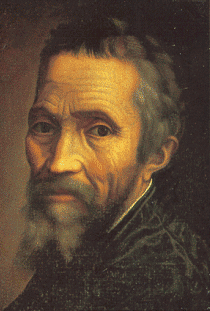
As an artist he was unmatched, the creator of works of sublime beauty that express the full breadth of the human condition. Yet in a world where art flourished only with patronage, Michelangelo was caught between the conflicting powers and whims of the Medici family in Florence, and the Papacy in Rome. Unlike many artists of his time, his genius was recognized, but at what cost to his personal life?

At first, Buonarroti tried to turn down the commission, but in vain. And then, during the realization of the work, that mysterious liking that the artist and the pope had, at bottom, for one another yielded its fruit. Julius II let himself be swayed by Michelangelo's creative frenzy, and both were carried away by their enthusiasm over more and more ambitious plans. So, Michelangelo was given carte blanche: by October 31st, 1512, he had painted over 300 figures on the ceiling of the Sistine Chapel.
In May 1508, Michelangelo began to make the preparatory designs for the Sistine ceiling. It was not until the fall that he started the actual painting, calling on the assistance of Giuliano Bugiardini, Aristotele da Sangallo, and his old friend Francesco Granacci, along with a number of laborers.
However the work did not proceed as the master wished, and he soon fired all of his assistants, removed what had already been painted and, between the end of 1508 and January 1509, recommenced the whole demanding enterprise on his own. Condivi recalls that "as a result of having painted for so long a time, keeping his eyes fixed on the ceiling, he saw little when he looked down; if he had to read a letter or some other small thing, he was obliged to hold it above his head."
Extremely jealous of his work, he refused to show it to anyone but the pope, though the latter was always insisting that he finish it quickly, and often climbed the scaffolding to see how the fresco was proceeding. The pressure on the artist was such that he uncovered it in August 1511, even before it was finished. The sight of these highly original paintings made a great impression on the artists of the time. Raphael, who was painting the nearby Stanze, was so influenced by them that his own style altered as a result, becoming more plastic and sculptural as the decoration proceeded.
The project was physically and emotionally torturous for Michelangelo. Michelangelo recounts its effect on him with these words: "After four tortured years, more than 400 over life-sized figures, I felt as old and as weary as Jeremiah. I was only 37, yet friends did not recognize the old man I had become."
Working high above the chapel floor, on scaffolding, Michelangelo painted, between 1508 and 1512, some of the finest pictorial images of all time. On the vault of the papal chapel, he devised an intricate system of decoration that included nine scenes from the Book of Genesis, beginning with God Separating Light from Darkness and including the Creation of Adam and Eve, the Temptation and Fall of Adam and Eve, and the Flood. These centrally located narratives are surrounded by alternating images of prophets and sibyls (Libyan, Erythraean) on marble thrones, by other Old Testament subjects, and by the ancestors of Christ. In order to prepare for this enormous work, Michelangelo drew numerous figure studies and cartoons, devising scores of figure types and poses. These awesome, mighty images, demonstrating Michelangelo's masterly understanding of human anatomy and movement, changed the course of painting in the West.
This comes from dangling from the ceiling–
I'm goitered like a Lombard cat
(or wherever else their throats grow fat)–
it's my belly that's beyond concealing,
it hands beneath my chin like peeling.
My beard points skyward, I seem a bat
upon its back, I've breasts and splat!
On my face the paint's congealing.
Loins concertina'd in my gut,
I drop an arse as counterweight
and move without the help of eyes.
Like a skinned martyr I abut
on air, and, wrinkled, show my fat.
Bow-like, I strain toward the skies.
No wonder then I size
things crookedly; I'm on all fours.
Bent blowpipes send their darts off-course.
Defend my labor's cause,
good Giovanni, from all strictures:
I live in hell and paint its pictures.
Michelangelo Buonarroti